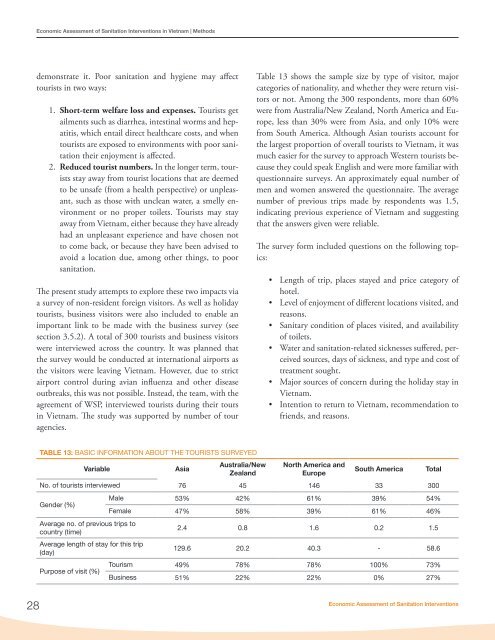Economic Assessment of Sanitation Interventions in Vietnam - WSP
Economic Assessment of Sanitation Interventions in Vietnam - WSP
Economic Assessment of Sanitation Interventions in Vietnam - WSP
Create successful ePaper yourself
Turn your PDF publications into a flip-book with our unique Google optimized e-Paper software.
<strong>Economic</strong> <strong>Assessment</strong> <strong>of</strong> <strong>Sanitation</strong> <strong>Interventions</strong> <strong>in</strong> <strong>Vietnam</strong> | Methodsdemonstrate it. Poor sanitation and hygiene may affecttourists <strong>in</strong> two ways:1. Short-term welfare loss and expenses. Tourists getailments such as diarrhea, <strong>in</strong>test<strong>in</strong>al worms and hepatitis,which entail direct healthcare costs, and whentourists are exposed to environments with poor sanitationtheir enjoyment is affected.2. Reduced tourist numbers. In the longer term, touristsstay away from tourist locations that are deemedto be unsafe (from a health perspective) or unpleasant,such as those with unclean water, a smelly environmentor no proper toilets. Tourists may stayaway from <strong>Vietnam</strong>, either because they have alreadyhad an unpleasant experience and have chosen notto come back, or because they have been advised toavoid a location due, among other th<strong>in</strong>gs, to poorsanitation.The present study attempts to explore these two impacts viaa survey <strong>of</strong> non-resident foreign visitors. As well as holidaytourists, bus<strong>in</strong>ess visitors were also <strong>in</strong>cluded to enable animportant l<strong>in</strong>k to be made with the bus<strong>in</strong>ess survey (seesection 3.5.2). A total <strong>of</strong> 300 tourists and bus<strong>in</strong>ess visitorswere <strong>in</strong>terviewed across the country. It was planned thatthe survey would be conducted at <strong>in</strong>ternational airports asthe visitors were leav<strong>in</strong>g <strong>Vietnam</strong>. However, due to strictairport control dur<strong>in</strong>g avian <strong>in</strong>fluenza and other diseaseoutbreaks, this was not possible. Instead, the team, with theagreement <strong>of</strong> <strong>WSP</strong>, <strong>in</strong>terviewed tourists dur<strong>in</strong>g their tours<strong>in</strong> <strong>Vietnam</strong>. The study was supported by number <strong>of</strong> touragencies.Table 13 shows the sample size by type <strong>of</strong> visitor, majorcategories <strong>of</strong> nationality, and whether they were return visitorsor not. Among the 300 respondents, more than 60%were from Australia/New Zealand, North America and Europe,less than 30% were from Asia, and only 10% werefrom South America. Although Asian tourists account forthe largest proportion <strong>of</strong> overall tourists to <strong>Vietnam</strong>, it wasmuch easier for the survey to approach Western tourists becausethey could speak English and were more familiar withquestionnaire surveys. An approximately equal number <strong>of</strong>men and women answered the questionnaire. The averagenumber <strong>of</strong> previous trips made by respondents was 1.5,<strong>in</strong>dicat<strong>in</strong>g previous experience <strong>of</strong> <strong>Vietnam</strong> and suggest<strong>in</strong>gthat the answers given were reliable.The survey form <strong>in</strong>cluded questions on the follow<strong>in</strong>g topics:• Length <strong>of</strong> trip, places stayed and price category <strong>of</strong>hotel.• Level <strong>of</strong> enjoyment <strong>of</strong> different locations visited, andreasons.• Sanitary condition <strong>of</strong> places visited, and availability<strong>of</strong> toilets.• Water and sanitation-related sicknesses suffered, perceivedsources, days <strong>of</strong> sickness, and type and cost <strong>of</strong>treatment sought.• Major sources <strong>of</strong> concern dur<strong>in</strong>g the holiday stay <strong>in</strong><strong>Vietnam</strong>.• Intention to return to <strong>Vietnam</strong>, recommendation t<strong>of</strong>riends, and reasons.TABLE 13: BASIC INFORMATION ABOUT THE TOURISTS SURVEYEDVariableAsiaAustralia/NewZealandNorth America andEuropeSouth AmericaNo. <strong>of</strong> tourists <strong>in</strong>terviewed 76 45 146 33 300Gender (%)Average no. <strong>of</strong> previous trips tocountry (time)Average length <strong>of</strong> stay for this trip(day)Purpose <strong>of</strong> visit (%)Male 53% 42% 61% 39% 54%Female 47% 58% 39% 61% 46%2.4 0.8 1.6 0.2 1.5Total129.6 20.2 40.3 - 58.6Tourism 49% 78% 78% 100% 73%Bus<strong>in</strong>ess 51% 22% 22% 0% 27%28<strong>Economic</strong> <strong>Assessment</strong> <strong>of</strong> <strong>Sanitation</strong> <strong>Interventions</strong>
















